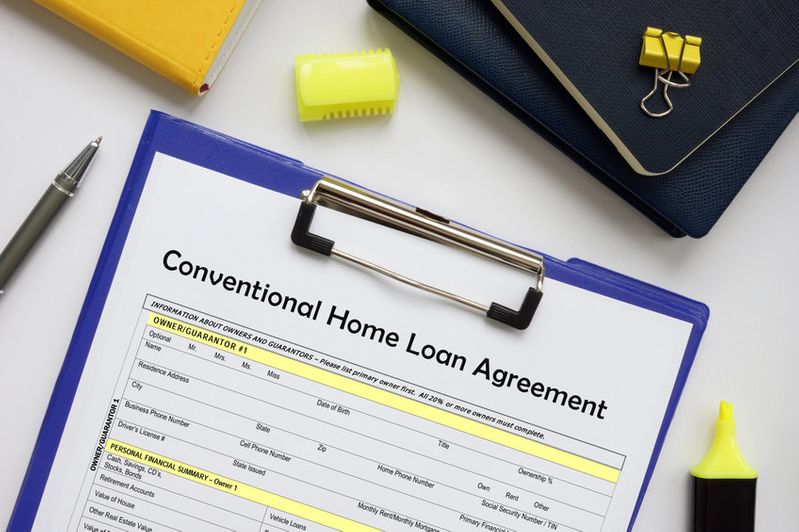First-time home buyers often encounter new (and confusing) jargon when they are applying for a home loan. "Conforming loan," "fixed-rate," and "funding fee" are just a few to name. However, the most confusing term by far is "conventional mortgage."
What is a conventional mortgage? If there are conventional mortgages, what are unconventional mortgages? What is the difference between these two types of home loans? We will answer these questions and more in this blog post.
A conventional mortgage, also known as a conventional loan, is a home buyer's loan that funds 80% or less of the purchase price of the property. Since the loan limit is 80%, buyers need to have a 20% down payment saved up and available to them to qualify for a conventional loan.
For instance, a couple looking to buy a $450,000 house should have $90,000 saved for their down payment.
While saving this much may be possible for some people, many first-time homebuyers have a hard time saving up such a large down payment amount because they have debt (e.g., outstanding student loans).
Since the maximum loan amount is 80% of the mortgage, conventional mortgages tend to not have any form of high-ratio or mortgage insurance premiums. We'll touch more on that later.

Unconventional, non-traditional, or high ratio mortgages are the exact opposite of conventional mortgages. Unconventional mortgages cover more than 80% of the total closing costs.
A home buyer may not qualify for a conventional loan for many possible reasons, including but not limited to:
In these cases, a buyer's loan options become extremely limited because banks and mortgage companies are wary of lending their money to individuals with these types of financial portfolios. As a result, buyers must choose mortgages supported by the federal government.
Fun fact: Non-traditional mortgages must be backed by a government agency. These types of mortgages help protect the lender, not the borrower.
It is important to note that conventional loans are not the standard; buyers are required to have a minimum down payment of 5% for a primary residence or 20% for an investment property. You can still purchase a home without having a 20% down payment saved up, but it may have additional loan limits and regulations you need to follow.
Conventional loans have many benefits that you can enjoy. We'll go into depth on some of the benefits you can enjoy if you save enough to receive a conventional loan.

A conventional loan is more beneficial for homebuyers because they have more equity right at the beginning of their loan.
Since buyers with a conventional loan have paid a larger down payment for their property, they have more equity in their homes. More equity can be extremely beneficial because it provides owners with access to a larger home equity loan or home equity line of credit.
Mortgage insurance protects lenders in case the borrower defaults on their mortgage payments. Insurance typically costs 2.8% to 4.0% of the total mortgage amount. When you pay private mortgage insurance (PMI) on top of your mortgage loans, it puts a strain on your ability to make your monthly payments.
Thankfully, mortgage insurance is usually only required for any loan that is over 80% of the home's purchase price or market value. Therefore, homeowners with conventional loans don't have to buy mortgage insurance.
The mortgage industry has requirements that borrowers need to meet and follow. These requirements include proving your credit score, source of income, and more. While these terms are usually the same, they can differ depending on whether you are receiving a conventional or high ratio mortgage.
Unconventional mortgages are given to buyers who have a low down payment, poor credit score, etc. Since buyers do not have what lenders consider a 'stable financial portfolio,' they receive stricter lending requirements. As a result, they may have to go above and beyond to prove that they are responsible borrowers.

Often, borrowers can receive lower interest rates when they have a conventional mortgage rather than an unconventional one. The interest rate that you receive is an important determinant of your finances. Interest rate affects the amount of your monthly mortgage payment and, as a result, the cost of your total loan.
For example, if you secure a 25-year mortgage for $400,000 with a 3% interest rate, you can expect to pay $146,963.60 in interest in the 25 years. You will have to pay $253,187.39 in interest if you receive the same loan with a 5% interest rate.
Borrowers usually only receive lower rates when they have a good credit score and a low debt to income ratio. We recommend bringing your credit report to lenders to learn what interest rates they can offer you.
The first thing that you need to do is to gather all the materials required by lending services. You should have a copy of your credit report, proof of employment and any financial records to show to potential lenders.
Once you have that information collected, visit private lenders like banks, credit unions, and mortgage companies to inquire about a mortgage loan. We strongly recommend speaking to a mortgage broker because they will help you find the best rates.
What are unconventional mortgages?
Unconventional mortgages are non-traditional home loans that differ from standard fixed-rate or adjustable-rate mortgages. They often have unique features, such as alternative qualification criteria or repayment structures.
How do unconventional mortgages differ from conventional mortgages?
Conventional mortgages follow standard lending guidelines, while unconventional mortgages deviate from these norms. Unconventional mortgages may have lower credit score requirements, interest-only payments, or balloon payments.
What types of unconventional mortgages are available?
Unconventional mortgages encompass various types, including interest-only mortgages, adjustable-rate mortgages (ARMs), subprime mortgages, jumbo loans, and more.
What is an interest-only mortgage?
An interest-only mortgage allows borrowers to pay only the interest portion of the loan for a specified period, typically 5-10 years. After this initial period, they must start repaying both principal and interest.
How do adjustable-rate mortgages (ARMs) fit into unconventional mortgages?
ARMs start with a fixed interest rate for a set period, after which the rate adjusts periodically based on market conditions. They can be considered unconventional due to the uncertainty of future interest rate changes.
What is a subprime mortgage?
Subprime mortgages are loans offered to borrowers with lower credit scores or less conventional credit histories. They often have higher interest rates to compensate for the increased risk to lenders.
Why do people choose unconventional mortgages?
Borrowers may opt for unconventional mortgages if they have unique financial situations, such as irregular income, limited credit history, or the need for short-term financing.
Is it advisable to consider an unconventional mortgage?
The suitability of an unconventional mortgage depends on your specific financial circumstances and goals. It's essential to carefully evaluate your ability to manage potential risks and consult with a mortgage professional to make an informed decision.